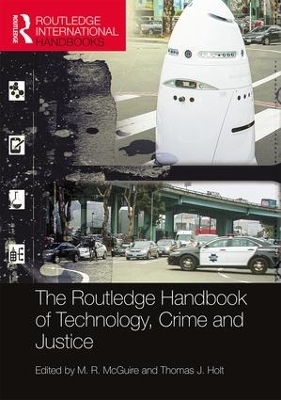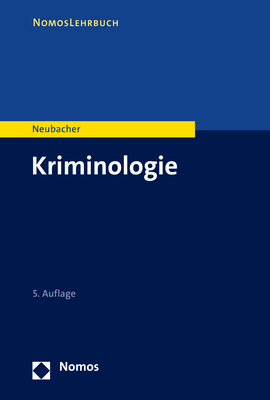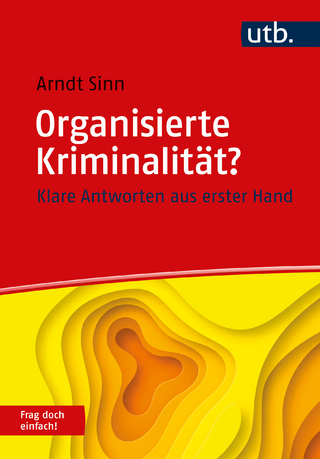
The Routledge Handbook of Technology, Crime and Justice
Routledge (Verlag)
978-1-138-82013-5 (ISBN)
Technology has become increasingly important to both the function and our understanding of the justice process. Many forms of criminal behaviour are highly dependent upon technology, and crime control has become a predominantly technologically driven process – one where ‘traditional’ technological aids such as fingerprinting or blood sample analysis are supplemented by a dizzying array of tools and techniques including surveillance devices and DNA profiling.
This book offers the first comprehensive and holistic overview of global research on technology, crime and justice. It is divided into five parts, each corresponding with the key stages of the offending and justice process:
Part I addresses the current conceptual understanding of technology within academia and the criminal justice system;
Part II gives a comprehensive overview of the current relations between technology and criminal behaviour;
Part III explores the current technologies within crime control and the ways in which technology underpins contemporary formal and informal social control;
Part IV sets out some of the fundamental impacts technology is now having upon the judicial process;
Part V reveals the emerging technologies for crime, control and justice and considers the extent to which new technology can be effectively regulated.
This landmark collection will be essential reading for academics, students and theorists within criminology, sociology, law, engineering and technology, and computer science, as well as practitioners and professionals working within and around the criminal justice system.
M. R. McGuire is Senior Lecturer in Criminology at the University of Surrey, UK. Thomas J. Holt is Professor of Criminal Justice at Michigan State University, USA.
Introduction M. R. McGuire
Part I Technology, Crime and Justice: Theory and History
1. Theorizing Technology and its Role in Crime and Law Enforcement Phillip Brey
2. Technology Crime and Technology Control: Contexts and History M. R. McGuire
Part II Technology, Crime and Harm
Section 1 Information Communication Technologies (ICTs) and Digital Crime
3. The Evolving Landscape of Technology-Dependent Crime Steven Furnell
4. Technology and Fraud: The ‘Fraudogenic’ Consequences of the Internet Revolution Mark Button and Cassandra Cross
5. ICTs and Child Sexual Offending: Exploitation Through Indecent Images Jo Bryce
6. ICTs and Sexuality Andrew S. Denney and Richard Tewkesbury
7. ICTs and Interpersonal Violence Thomas J. Holt
8. Online Pharmacies and Technology Crime Chris Jay Hoofnagle, Ibrahim Altaweel, Jaime Cabrera, Hen Su Choi, Katie Ho, and Nathaniel Good
9. The Theft of Ideas as a Cybercrime: Downloading and Changes in the Business Model of Creative Arts David S. Wall
10. ICTS, Privacy and the (Criminal) Misuse of Data Andrew Puddephatt
Section 2 Chemical and Biological Technologies and Crime
11. Crime and Chemical Production Kimberley Barrett
12. Pharmatechnologies and the Ills of Medical Progress Paddy Rawlinson
13. Bioengineering and Biocrime Victoria Sutton
Keynote Discussion
14. Technology, Environmental Harm and Green Criminology Rob White
Section 3 Wider Varieties of Technology Crime
15. Guns, Technology and Crime Peter Squires
16. Crime, Transport and Technology Andrew Newton
17. Food Fraud and Food Fraud Detection Technologies Roy Fenoff and John Spink
18. Consumer Technologies, Crime and Environment Implications Avi Brisman and Nigel South
Keynote Discussion: Technology, Crime and Harm
19. Evaluating Technologies as Criminal Tools Max Kilger
Part III Technology and Control
20. Crime, Situational Prevention and Technology: The Nature of Opportunity and How it Evolves Paul Ekblom
21. Technology, Innovation and Twenty-First-Century Policing Don Hummer and Jim Byrne
22. Contemporary Landscapes of Forensic Innovation Christopher Lawless
23. Technology and Digital Forensics Marc Rodgers
24. DNA and Identification Carole McCartney
25. Visual Surveillance Technologies Richard Jones
26. Big Data, Predictive Machines and Security: The Minority Report Adam Edwards
27. Cognitive Neuroscience, Criminal Justice and Control Lisa Claydon
Keynote Discussion: Technology and Control
28. The Uncertainty Principle: Qualification, Contingency, and Fluidity in Technology and Social Control Gary. T. Marx and Keith Guzik
Part IV Technology and the Process of Justice
29. Establishing Culpability: Forensic Technologies and Justice Simon A. Cole
30. Technology-augmented and Virtual Courts and Courtrooms Frederick I. Lederer
31. Computer-Assisted Sentencing Martin Wasik
32. The Technology of Confinement and Quasi-Therapeutic Control: Managing Souls with In-cell Television Victoria Knight
33. Punitivity and Technology Simon Hallsworth and Maria Kaspersson
34. Public and Expert Voices in the Legal Regulation of Technology Patrick Bishop and Stuart MacDonald
Keynote discussion: Technology and the Process of Justice
35. The Force of Law and the Force of Technology Mireille Hildebrandt
Part V Emerging Technologies of Crime and Justice
36. Nanocrime 2.0 Susan W. Brenner
37. AI and Bad Robots: The Criminology of Automation Ugo Pagallo
38. Technology, Body and Human Enhancement: Prospects and Justice Jérôme Goffette
Keynote discussion: Technology and Justice
39. Technology and Justice Albert Borgmann
| Erscheinungsdatum | 24.05.2016 |
|---|---|
| Reihe/Serie | Routledge International Handbooks |
| Zusatzinfo | 9 Tables, black and white; 13 Line drawings, black and white; 6 Halftones, black and white; 19 Illustrations, black and white |
| Verlagsort | London |
| Sprache | englisch |
| Maße | 174 x 246 mm |
| Gewicht | 1360 g |
| Themenwelt | Naturwissenschaften |
| Recht / Steuern ► Strafrecht ► Kriminologie | |
| Sozialwissenschaften ► Soziologie ► Allgemeine Soziologie | |
| Technik | |
| ISBN-10 | 1-138-82013-X / 113882013X |
| ISBN-13 | 978-1-138-82013-5 / 9781138820135 |
| Zustand | Neuware |
| Informationen gemäß Produktsicherheitsverordnung (GPSR) | |
| Haben Sie eine Frage zum Produkt? |
aus dem Bereich


